I’ve finally found a setup for my gouache palette that I really like.
Here’s a video version of the post in which I show the palette in detail:
My favorite gouache palette setup
As some of you know, I’ve been painting more with gouache paint last year. What I didn’t mention is that it always felt like a huge ordeal compared to watercolor – since gouache is best used fresh, this means squeezing out new paint every time you want to paint. You can let your paint blobs dry and reactivate them, but they get crumbly and aren’t as nice to paint with.
During my first steps with the medium, I tried out all kinds of palettes I had, and ended up with a simple flat palette that I cleaned every time after painting. I added a strip of paper towel for the paints to sit on so that they stayed moist during painting. It worked, but still felt a lot of hassle and a lot of unused paint went to waste. Paint is expensive, and I didn’t like it. And I never took it with me anywhere.
I happened to buy an airtight plastic palette at some point that I saw another artist use. I usually like metal palettes better, but I figured I should at least give it a try. And somehow this made painting with gouache much easier and more practical – the paint stays moist in between sessions (if you paint every few days at least), and I don’t have to throw away paint any longer, which is a big plus.
What I use now is a Mijello Fusion folding palette with 18 wells and three mixing areas. It closes airtight, although it’s not sold as a stay-wet-palette. It still works that way, which means the paint stays fresh and moist. I sometimes add a tiny drop of glycerin to help my older, dryer paints. I’ve only had mold problems once with one color so far, the ivory black. The palette has a clear plastic insert that you can take out for cleaning, so cleaning has also become a lot easier. It’s always a big mess to clean palettes with integrated wells under a sink because water gets everywhere on the paint. Now I take out the insert, clean it with a brush and then under water. It’s just a bit fragile, so it already has a crack.
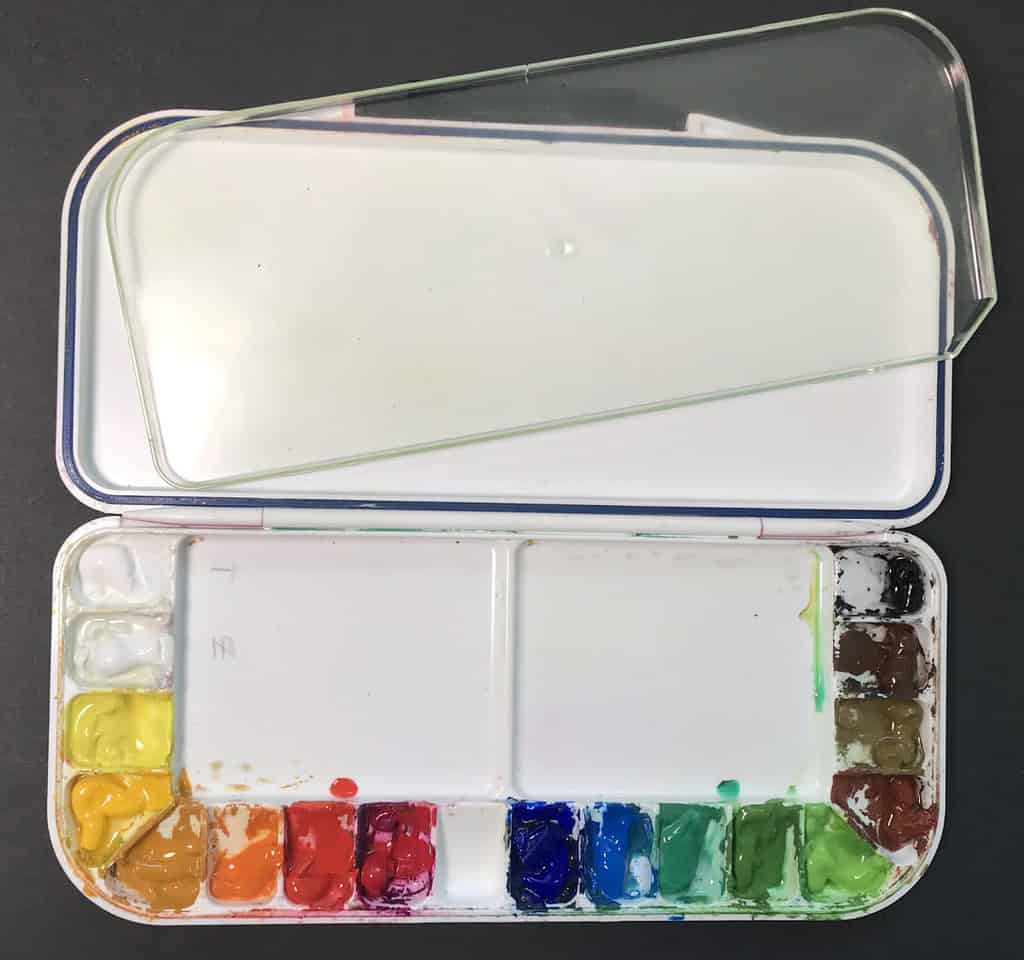
Overall I’m really happy with this palette. The only thing I don’t like is the size – it’s huge. I mean, it’s ok for studio use, everyone loves a big mixing area and big painting wells, but I’m not sure if I want to put it in my bag. For plein air painting (which I haven’t tried yet with this palette) I will have to think of a system to fix this palette to my support board and still have a place for the sketchbook! But I’ve seen other painters carry around palettes that were of a similar size, so it’s definitely possible. I’m simply not accustomed to it. The palette doesn’t have a thumb hole, probably because it wouldn’t be airtight otherwise. So it’s a bit less practical than the other watercolor palettes I use regularly. But it also means wet paint will stay inside the palette when you close it.
I’m really happy that I have discovered this kind of palette. Mijello have a number of similar ones with different layouts and wells. I chose the smallest one with 18 wells. There are similar plastic palettes than you can get for a very good price, but these are usually not airtight.
When I start a painting session, I add a little water on the paint with a spray bottle, and refill any wells that need new paint. When I’m done, I simply close the palette, and the paint stays fresh for the next session. In autumn 2020, I painted with gouache at least every few days and it worked great, now that I haven’t used the palette in over a month of course the paint has dried and cracked and I will need to replace it before use. But this is still much better than throwing away dried paint after every session.
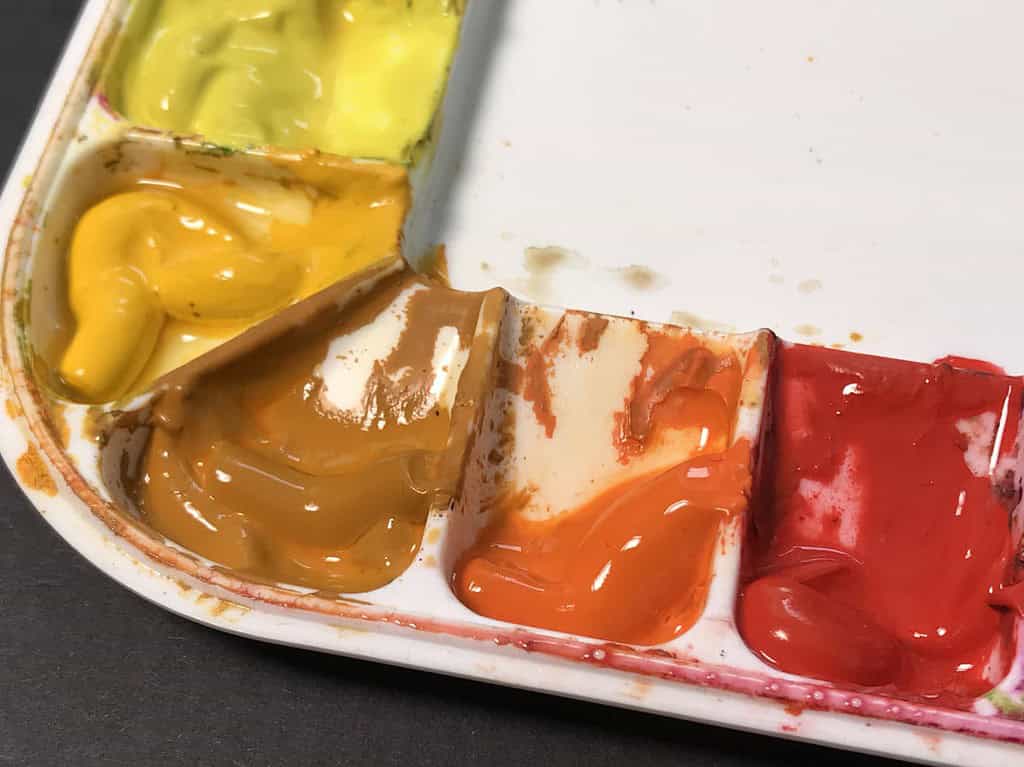
So enough talking about this great new palette, what colors did I put in it? I’ve filled the palette except for one well, which I’m currently using as a place to put my clamp in. Here are the colors:
Zink white (for mixing)
Titanium white (for opaque white)
Lemon Yellow
Permanent Yellow Deep
Yellow Ochre
Chrome Orange
Cadmium Red Light
Carmine Red or Purple Magenta
(empty well that I could put Dioxazine Violet in)
Ultramarine Blue
Phthalo Blue
Viridian Hue
Sap Green
May Green
Burnt Siena
Raw Umber
Burnt Umber
Ivory Black
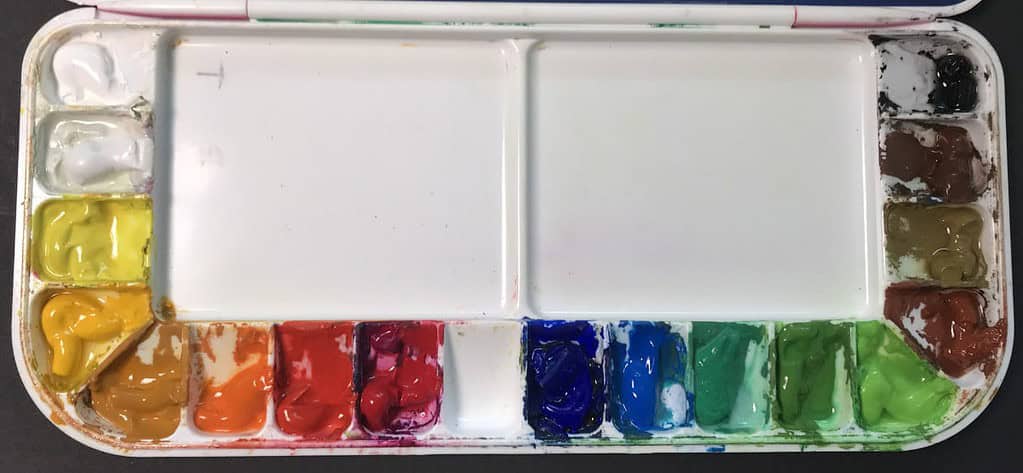
For me this is a well-balanced palette that gives me more than enough choices. You can of course use a more reduced palette – when I was still working with fresh paint for every session, I used 6 colors at the most. I find that I usually use a limited number of colors for each painting, it keeps the gamut (range of colors) smaller and often paintings seem better composed with limited colors, because all of the mixes work well together.
All paints in my palette are either Winsor & Newton Designer’s gouache or Schmincke HKS Designer’s Gouache/Horadam Gouache. I still have one tube of Royal Talens Extra fine, which is also nice, but increasingly hard to get in Germany. With this kind of palette you could probably even use cheaper gouache paint that doesn’t reactivate at all or is very crumbly, because the paint stays moist for so long, but I don’t bother anymore with the cheap stuff because it’s usually difficult to paint with.
For gouache, I don’t pay as much attention to single pigment paints as with watercolor – I have a couple of three-pigment mixes, but they perform really well for mixing. If you use colors that play well together when mixing, this is not a huge deal.
A note about the whites: if you only want to use one white, choose the titanium white. It’s more opaque and can cover dark areas. I added the zink white because I still have a large tube of it, and I find it a good white for mixing – it’s a bit more gentle and doesn’t cool down the color as much as the titanium white. But it’s also less opaque and won’t cover dark areas as well as titanium white.
I hope this is a helpful overview for those of you wanting to try out gouache. I have found that painting with this setup means I’m fighting less with gouache as a medium (which can be finicky) and can concentrate on the act of painting – which is hard enough. It’s important to find the tools that work for you. I still find myself going back to watercolor very often, because I’m more comfortable with handling it.
Have you tried out gouache? What does your setup look like? What’s your experience with different palettes?

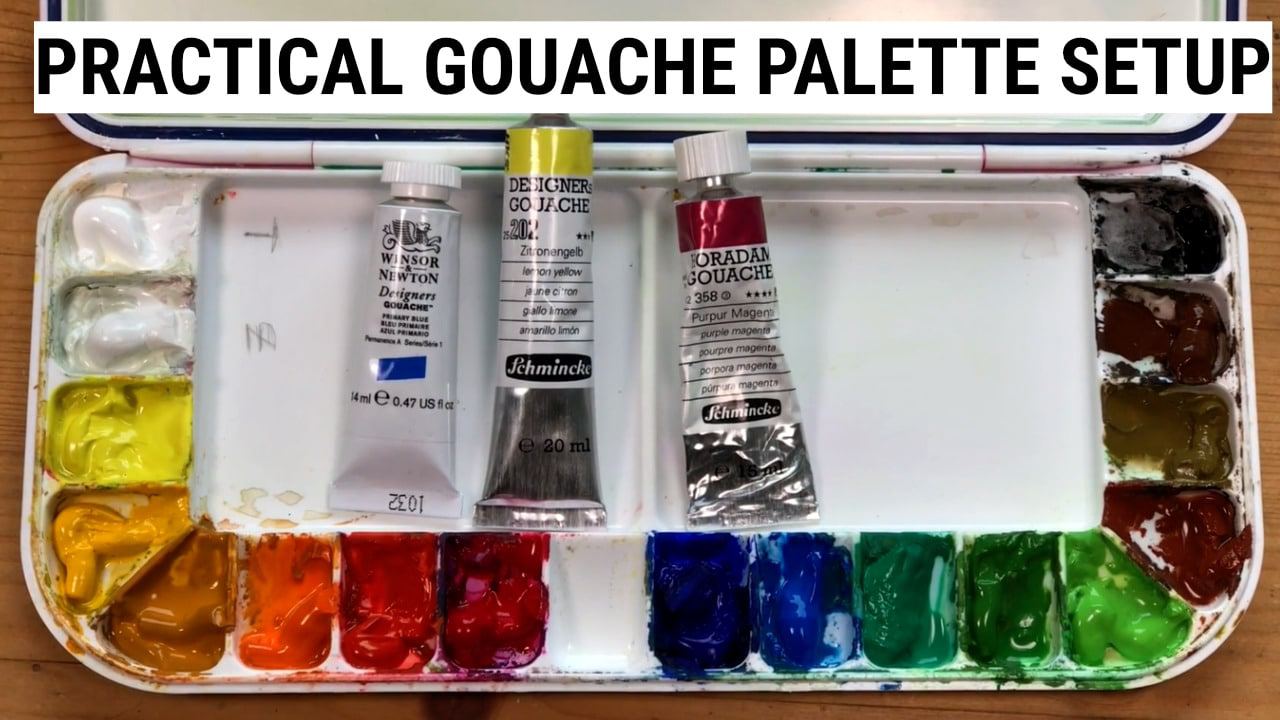

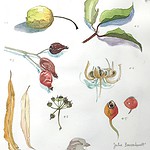
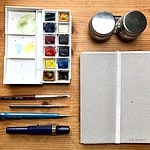
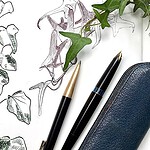
Hi Julia – I love all your content and resonate with a lot of it but this is perfect timing for me. I love watercolour but when I’ve used gouache I’ve really loved it and it almost feels more intuitive to me. I travel and sketch outdoors a lot and want to keep my supplies to a minimum in general so I’ve stuck to a little metal watercolour palette for now. I have a few tubes of gouache with me but I almost never use the gouache because like you I find it cumbersome to use and squeeze out gouache and then have to waste it everytime especially when I know it is rewettable. Your perspective has tipped me over to trying these palettes. I want to use gouache a lot more and hopefully will if this palette allows it to stay moist for a few days. It is worth a shot. Thanks!
That’s great to hear and I hope you’ll find this kind of palette useful, too!
Hi Julia
Enjoyed your article about your gouache pallet.
Have you worked with acrylic paint? Is it simular to gouache.
Our local hobby store only carry acrylic paints.
Again very much enjoy your articles.
Thank you Dave! I’ve painted with acrylic years ago, we learnt painting with acrylic in art school. It is indeed very similar to gouache. I found I throw a lot of paint away with acrylic, but it’s nice that the layers stay put after they dry.
this was so helpful! thank you so much ❤️
I use this same 18 well palette, when I do larger field studies ( on a stretched paper or watercolour block). I don’t normally travel with an easel or a tripod, as I am a bit more guerilla in my sketching. If I use anything, I take a salvaged piece of crate plywood, sanded and finished for use as a drawing board.
When I can’t set the palette next to me, I have glued strong magnets to the top lid, and suspend the palette from a couple of steel bulldog clips on the top of my board. This palette has been incredibly durable and has held up well with a lot of abuse from travel.
These are great solutions, Andrew! I also improvise a lot when I’m painting outside – you can’t go wrong with magnets!! 😉
I enjoyed your video today! I have this palette and I like it very much, but I use it for watercolor. I was very interested in the selection of colors that you chose. I’m looking forward to a video where you use those colors to paint — I love watching you paint.
Thank you Julie! I imagine the palette will also work great for watercolor. I think I already did a gouache demo with this palette, it should be the last gouache landscape I shared (autumn forest). 🙂
Great video, and thanks so much for all the info you shared . I’ve recently also been seeking an alternative to just squeezing out the tunes on wet paper towels etc. I’ve been using an airtight box that has sections for each color. (https://www.amazon.com/dp/B07DYNHGKY?psc=1&ref=ppx_yo2_dt_b_product_details) I wish they have a smaller one , but it still only measures 3 1/4” x 6 1/2”. I’ve also been adding a small drop of clove oil to each well to help stop any potential mold. I’m currently using it every day , but have only been using it for a month. The paint is staying lovely and fresh. I also give it a spray with water as you do when I start painting. So far it’s made a huge difference having all the colors ready to use. The only slight drag is there is no palette, but it’s not the end of the world. I think I will also get the Mijello too. Thanks again. BTW where did you buy the glycerin? Good idea too. I do like the smell of the clove oil though!
That looks like a really interesting palette, and great that the clove oil prevents mold. Thanks for sharing! I got the glycerin in a drugstore, it was much cheaper than the version from the art supply shop, and it’s exactly the same.
Can you paint on a canvas with the gouche
You can if you use primer, but it’s not advisable because when gouache dries it’s very brittle – there are no oils or elastic binders left, just pigment and chalk. It can crack if you move or fold your canvas.